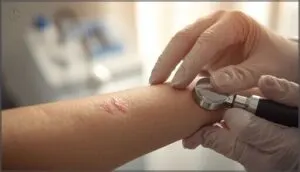This site is supported by our readers. We may earn a commission, at no cost to you, if you purchase through links.

Your skin functions as your body’s first line of defense against infection, injury, and environmental damage. When that barrier breaks down, the consequences range from mild irritation to chronic conditions that affect your quality of life.
The good news? Most skin problems don’t appear out of nowhere. Eczema flares, premature aging, even certain skin cancers develop over time through repeated exposure to triggers you can identify and avoid.
Understanding which daily habits protect your skin and which ones silently damage it gives you control over your skin’s health. Small, consistent changes to your routine can prevent common conditions before they start, saving you from discomfort and expensive treatments down the road.
Table Of Contents
- Key Takeaways
- What Are Common Preventable Skin Conditions?
- How Does Daily Skin Care Prevent Conditions?
- Why is Sun Protection Essential for Skin Health?
- What Lifestyle Habits Support Healthy Skin?
- How Can Proper Hygiene Prevent Skin Problems?
- When Should You Seek Medical Advice?
- Frequently Asked Questions (FAQs)
- Conclusion
Key Takeaways
- Your daily habits—like using gentle cleansers, moisturizing within minutes of bathing, and applying broad-spectrum sunscreen—directly strengthen your skin’s barrier and prevent conditions like eczema, psoriasis, and skin cancer before they develop.
- Early melanoma detection through regular self-exams improves survival rates from 88% to 99%, making it essential to watch for warning signs like asymmetry, irregular borders, color changes, or moles larger than 6mm.
- Lifestyle factors including adequate sleep (7-9 hours), stress management, proper hydration, and avoiding smoking can reduce eczema flares by up to 30% and improve collagen synthesis by 40% compared to poor habits.
- Seeking medical advice within 24 hours for rapidly spreading rashes or persistent symptoms lasting beyond four weeks is critical, as 25% of skin conditions are initially misdiagnosed and early intervention reduces treatment complexity by 20-30%.
What Are Common Preventable Skin Conditions?
Skin problems come in many forms, but some are easier to avoid than others. Knowing what these conditions look like can help you spot trouble early and stay ahead of potential issues.
Here are a few preventable skin concerns you should keep in mind.
Eczema and Dermatitis
From the daily concerns of itchy skin to stubborn rashes, eczema and dermatitis often start with simple triggers—think soaps, dust, or stress. Improving your skin’s barrier function and practicing good itch management can make a real difference.
To prevent flare-ups, you’ll want to:
- Avoid Eczema triggers when possible
- Moisturize daily for better skin care
- Try gentle cleansers
- Use topical steroids only as prescribed
- Recognize pediatric eczema patterns early
Awareness and routine—in dermatology, prevention is half the battle. Researchers often utilize MEDLINE and CINAHL databases when studying qualitative research.
Psoriasis and Autoimmune Skin Issues
If you’re managing eczema, you might notice new challenges with psoriasis or other autoimmune skin issues. Psoriasis triggers—like stress, infections, or even skin trauma (known as the Koebner phenomenon)—can leave lasting marks. Awareness of autoimmune comorbidities such as psoriatic arthritis is key. That’s why dermatologist-guided care, including new biologic therapies, makes all the difference.
| Psoriasis Feature | What to Know |
|---|---|
| Triggers | Stress, trauma, infection |
| Koebner Phenomenon | Lesions from skin injury |
| Autoimmune Comorbidities | Example: Psoriatic arthritis |
| Biologic Therapies | Targeted, highly effective |
| Skin Inflammation | Requires specialized care |
Sun Damage and Skin Cancer
Just as psoriasis calls for careful attention, so does protecting your skin from sun damage and skin cancer. Ultraviolet exposure, especially UVB radiation, leaves a lasting mark—think back to childhood sunburns or tanning bed risks.
For melanoma prevention, focus on:
- Proper sunscreen application
- Wearing UPF clothing
- Seeking shade midday
- Avoiding intentional tanning
Your habits matter—start now.
Considering how technology impacts society, it’s also important to be aware of digital manipulation of photos and the unrealistic beauty standards they can promote.
How Does Daily Skin Care Prevent Conditions?
The foundation of healthy skin starts with everyday care. Small steps taken each day really can make a difference. Here’s what goes into an effective daily routine.
Importance of Gentle Cleansing
Did you know harsh cleansers can chip away at your skin’s barrier function, much like sandpaper on a painted wall? Stick with a gentle, pH-balanced cleanser, use lukewarm water, and wash twice daily—no more, no less. Watch for product ingredients that might irritate.
These simple skin care tips are key for proper skin hygiene and lasting skin health.
Moisturizing and Hydration
From the moment you step out of the shower, your skin’s thirst for moisture kicks in. Lock it in within three minutes—a staple of daily routines. Reach for fragrance-free moisturizing creams rich in ceramides or hyaluronic acid to strengthen your skin barrier and soothe dry skin. Hydration strategies keep your skin resilient, no matter the conditions.
- Instant comfort after applying your favorite moisturizer
- Dry skin becomes soft, supple, and calm
- A consistent routine means fewer flakes and itchiness
- Protects your skin barrier as temperatures change
- Feels like self-care you can see and feel
Choosing Products for Your Skin Type
For skin care that truly works, match your moisturizer and sunscreen to your needs. Oily skin loves lightweight, non-comedogenic layers, while dry skin finds comfort in richer, barrier-repair creams. Sensitive skin? Stick with fragrance-free, gentle picks.
For combination skin, product layering helps—balance your routine and you’ll minimize skin conditions before they start. Choose with intention, and your skin notices.
Why is Sun Protection Essential for Skin Health?
Protecting your skin from the sun is more than just a summer concern. Every day, your skin faces invisible risks just from being outdoors.
Here’s what you need to know to keep your skin safe and healthy.
Dangers of UV Exposure
Did you know a few sunburns as a child can double your risk of melanoma later? UV Index peaks midday, and even short exposure can trigger damage. Here’s what ramps up skin cancer risk:
- Lifelong UV light exposure increases melanoma incidence
- Outdoor workers face more sun-related issues
- Childhood sunburns leave lasting effects
- Photoaging effects—wrinkles, discoloration—accelerate without sun protection
Effective Sunscreen Use
Think of sunscreen as your daily shield against UV light. Choose a broad-spectrum formula for maximum sun protection and opt for mineral sunscreens if your skin is sensitive.
Apply generously—don’t skimp—and make SPF reapplication a habit, especially after swimming. Water resistance matters, but no product’s perfect, so be vigilant; skin cancer prevention depends on your consistency.
Protective Clothing and Shade Practices
When you can’t stay inside, protective clothing becomes your frontline defense. Wide-brim hats cut facial UV exposure in half, while UPF clothing blocks over 90% of harmful rays. Shade structures reduce midday UV exposure by up to 50%.
Choose breathable fabrics that maintain moisture—they’ll keep you cooler under the sun.
These simple barriers work alongside sunscreen for complete skin cancer prevention.
What Lifestyle Habits Support Healthy Skin?
Your skin reflects what’s happening inside your body, and the daily choices you make have a real impact on its health. Simple shifts in how you eat, sleep, and manage stress can strengthen your skin’s natural defenses and reduce your risk of developing common conditions.
Let’s look at three key lifestyle habits that support healthy skin from the inside out.
Balanced Diet and Hydration
What you eat and drink shapes your skin’s health from the inside out. Your diet’s impact on skin hydration can’t be overstated—adults drinking enough water show 20–30% higher skin turgor scores.
To support healthy bones and vibrant skin, focus on:
- Nutrient absorption through gut health: Choose antioxidant-rich berries and leafy greens
- Adequate hydration levels: Drink water consistently throughout your day
- Omega-3s and vitamin C: These reduce dryness by 12% and boost collagen synthesis
Sleep and Stress Management
Getting seven to nine hours of quality sleep nightly significantly benefits skin health. It reduces transepidermal water loss by 19% and accelerates barrier recovery by 24%. Conversely, chronic poor sleep quality or high stress levels can trigger eczema flares and worsen psoriasis. Stress reduction programs have been shown to lower itch severity by up to 30%. As a result, clinical guidelines now recommend incorporating mindfulness practices and maintaining consistent bedtimes alongside traditional topical treatments.
| Sleep & Stress Factor | Impact on Your Skin |
|---|---|
| Quality sleep (7–9 hours) | Reduces water loss, faster healing |
| Chronic sleep disruption | Increases eczema flares, barrier dysfunction |
| High psychological stress | Doubles dermatitis flare frequency |
| Stress-reduction programs | Cuts itch severity 15–30% |
Avoiding Smoking and Excess Alcohol
Nicotine and skin health don’t mix well—smokers show up to 40% reduced collagen synthesis, slowing wound healing noticeably. Alcohol’s impact on dermatitis risk is equally concerning, with regular intake linked to increased contact dermatitis flares.
The good news? Cessation benefits are real. Quitting smoking before or after skin conditions appear improves treatment outcomes and reduces recurrence, making lifestyle factors and skin diseases deeply connected.
How Can Proper Hygiene Prevent Skin Problems?
Good hygiene isn’t just about staying clean—it’s your first line of defense against infections, irritation, and a host of preventable skin problems. When you practice proper hygiene consistently, you create an environment where your skin can function at its best, warding off bacteria and reducing your risk of complications.
Let’s look at three essential hygiene practices that protect your skin every day.
Handwashing and Showering Tips
Wash your hands for at least 20 seconds using soap and lukewarm water—hot water strips your skin’s protective barrier. Regular handwashing can cut skin infections by up to 60%, but over-washing dries you out.
For showers, keep them under 10 minutes with gentle, fragrance-free cleansers. Pat dry with a clean towel, then moisturize within five minutes to lock in hydration.
Care for Wounds and Cuts
When you cut yourself, clean it with soap and water for at least 20 seconds—this wound cleaning method cuts infection prevention signs like redness by half.
Apply dressing application tips: keep it moist, not dry, to speed healing process factors by 40%. Change bandages daily and watch for infected skin.
Proper wound care and medical treatment when needed are your best scar minimization strategies for healthy wound healing.
Preventing Spread of Contagious Skin Conditions
When contagious skin diseases strike, proper hygiene practices can cut transmission by 25–40%. Here’s how you protect yourself and others:
- Wash hands thoroughly—handwashing techniques and guidelines work best with soap for 20 seconds
- Isolate affected areas until treatment compliance reduces the contagious period
- Clean shared surfaces daily—disinfection of surfaces and equipment prevents spread in gyms
- Don’t share towels or razors, critical for skin infection prevention in athletes
- Consider vaccination benefits where available, reducing outbreaks by up to 90%
Hygiene awareness and surface sanitization make all the difference.
When Should You Seek Medical Advice?
You can manage some skin issues at home, but certain symptoms shouldn’t be ignored. Knowing when to call a dermatologist can make the difference between quick resolution and prolonged problems.
Let’s look at the key signs that warrant professional attention, how to handle ongoing conditions, and why acting early matters.
Recognizing Warning Signs
Knowing when to act isn’t guesswork—your skin speaks clearly. Any rash spreading quickly, severe swelling, or open lesions warrants urgent evaluation within 24 hours. Early melanoma detection improves survival from 88% to 99%, making self-exams essential. Watch for warning signs: asymmetry, irregular borders, color changes, diameter over 6 mm, or evolving lesions. Persistent symptoms lasting beyond four weeks need re-evaluation—25% of skin conditions are initially misdiagnosed.
Your skin signals danger clearly—spreading rashes need urgent care, while early melanoma detection can push survival from 88% to 99%
| Warning Sign | What to Watch For | Action Timeline |
|---|---|---|
| Acute spreading rash | Rapid expansion, severe swelling | Within 24 hours |
| Suspicious moles | Asymmetry, border irregularity, color variation | Schedule dermatology assessment |
| Non-healing lesions | Open sores lasting >4 weeks | Re-evaluate within 4–6 weeks |
| New/changing growths | Rapid size increase, bleeding, itching | Urgent if evolving rapidly |
Managing Chronic Skin Conditions
When you’re dealing with chronic skin conditions like eczema or psoriasis, consistent skin care practices and lifestyle changes become your strongest allies. These conditions affect millions globally—eczema impacts 10% of children, while psoriasis affects 2–3% of adults, driving healthcare costs substantially higher.
Managing them effectively means:
- Daily emollient application reduces flare frequency by 25–40%
- Stress reduction techniques lower psoriasis flares by 15–30%
- Smoking cessation improves skin severity scores by 20–40%
Your goal isn’t cure—it’s sustained remission and minimizing autoimmune impact while preventing actinic damage through vigilant sun protection.
Importance of Early Intervention
Catching skin problems early significantly improves outcomes. Addressing initial eczema signs with topicals and emollients results in 73% of individuals experiencing fewer flares within six months. Prompt care for actinic damage reduces the progression of non-melanoma cancer by 40% over a decade, while early psoriasis treatment lowers the need for stronger drugs by 20–30% annually.
| Condition | Early Intervention | Outcome |
|---|---|---|
| Eczema Management | Topicals + emollients within weeks | 73% reduced flare frequency in 6 months |
| Actinic Damage | Timely sun protection + monitoring | 40% lower cancer risk over 10 years |
| Psoriasis Treatment | Topicals + vitamin D analogs early | 20–30% fewer systemic therapies needed |
| Sunburn Relief | Hydration + cool compress immediately | 2–3 days faster redness resolution |
| Herpes Zoster | Antivirals within 72 hours of prodrome | 50–70% reduced acute neuralgia risk |
Prevention and skin hygiene habits are essential, but when symptoms appear, timely action is crucial. Early skincare practices can make a significant difference in managing and improving skin conditions.
Frequently Asked Questions (FAQs)
Can certain fabrics or materials trigger skin reactions?
About 5% of people experience flare-ups from wool fabrics, while nickel in clothing fasteners affects up to 15% of the population.
Synthetic irritants, weave density, and dye sensitivities can trigger allergies, causing itchy skin, rashes, and other skin conditions.
How does indoor air quality affect skin health?
Indoor humidity below 40% increases water loss from your skin, while VOCs from paints and cleaners can trigger eczema flares. Air filtration and proper ventilation rates help reduce irritation.
Are there specific vitamins that prevent skin conditions?
Your skin craves certain vitamins to stay strong. Vitamin D, Vitamin C, Vitamin E, Vitamin A, and B-complex vitamins help prevent skin conditions like dermatitis and psoriasis when you get enough daily.
Does water temperature during bathing impact skin health?
Yes, water temperature affects your skin barrier. Hot water above 40°C strips natural oils and increases irritation risk by 25%.
Warm baths at 37–38°C preserve skin hydration better, especially with immediate post-bathing moisture application.
Can hormonal changes increase risk of skin problems?
Absolutely. Hormonal changes during puberty, pregnancy, menopause, and conditions like PCOS can trigger acne and hormones interactions, pregnancy skin changes, menopause skin risks, and endocrine skin issues, affecting sebaceous glands and barrier function greatly.
Conclusion
Prevention puts power in your hands. The daily decisions you make—choosing sunscreen over shortcuts, moisturizing consistently, managing stress—directly determine your skin’s resilience against damage and disease.
Learning how to prevent skin conditions isn’t about being flawless; it’s about awareness and action. Your skin benefits from care, and the habits you build today protect you from chronic problems tomorrow.
Start with one change, then another. Your skin will show the difference.










